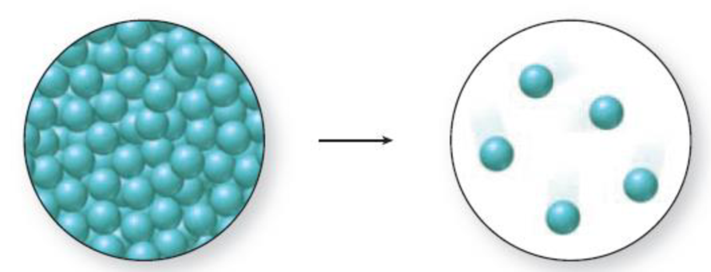
Principles of General, Organic, Biological Chemistry
2nd Edition
ISBN: 9780073511191
Author: Janice Gorzynski Smith Dr.
Publisher: McGraw-Hill Education
expand_more
expand_more
format_list_bulleted
Textbook Question
Chapter 4, Problem 4.30UKC
What phase change is shown in the accompanying molecular art? Is energy absorbed or released during the process?

Expert Solution & Answer
Want to see the full answer?
Check out a sample textbook solution
Chapter 4 Solutions
Principles of General, Organic, Biological Chemistry
Ch. 4.1 - Prob. 4.1PCh. 4.1 - Prob. 4.2PCh. 4.1 - Prob. 4.3PCh. 4.1 - Prob. 4.4PCh. 4.2 - Prob. 4.5PCh. 4.2 - Prob. 4.6PCh. 4.3 - Prob. 4.7PCh. 4.3 - Prob. 4.8PCh. 4.3 - Prob. 4.9PCh. 4.3 - Prob. 4.10P
Ch. 4.3 - Which of the compounds in each pair has stronger...Ch. 4.4 - Prob. 4.12PCh. 4.4 - Prob. 4.13PCh. 4.5 - A student has two containers one with 10 g of...Ch. 4.5 - Prob. 4.15PCh. 4.5 - How much energy is required to heat 28.0 g of iron...Ch. 4.5 - Prob. 4.17PCh. 4.5 - Prob. 4.18PCh. 4.5 - Prob. 4.19PCh. 4.6 - Prob. 4.20PCh. 4.6 - Prob. 4.21PCh. 4.6 - Label each process as endothermic or exothermic...Ch. 4.6 - Prob. 4.23PCh. 4.7 - Answer the following questions about the graph. a....Ch. 4.7 - Prob. 4.25PCh. 4.7 - If the cooling curve in Figure 4.5 represented a...Ch. 4.7 - How much energy (in calories) is released when...Ch. 4.7 - Prob. 4.28PCh. 4 - What phase change is shown in the accompanying...Ch. 4 - What phase change is shown in the accompanying...Ch. 4 - Consider the cooling curve drawn below. a. Which...Ch. 4 - Which line segments on the cooling curve in...Ch. 4 - Prob. 4.33UKCCh. 4 - Prob. 4.34UKCCh. 4 - Prob. 4.35UKCCh. 4 - Prob. 4.36UKCCh. 4 - Prob. 4.37UKCCh. 4 - Prob. 4.38UKCCh. 4 - Prob. 4.39APCh. 4 - Prob. 4.40APCh. 4 - Prob. 4.41APCh. 4 - Prob. 4.49APCh. 4 - Prob. 4.50APCh. 4 - Prob. 4.54APCh. 4 - Prob. 4.55APCh. 4 - Prob. 4.56APCh. 4 - Prob. 4.57APCh. 4 - Prob. 4.58APCh. 4 - Prob. 4.59APCh. 4 - Prob. 4.60APCh. 4 - Prob. 4.61APCh. 4 - Prob. 4.62APCh. 4 - Prob. 4.63APCh. 4 - Prob. 4.64APCh. 4 - Prob. 4.65APCh. 4 - Prob. 4.66APCh. 4 - Prob. 4.67APCh. 4 - Prob. 4.68APCh. 4 - Prob. 4.69APCh. 4 - Prob. 4.70APCh. 4 - Prob. 4.71APCh. 4 - Prob. 4.72APCh. 4 - Prob. 4.73APCh. 4 - Prob. 4.74APCh. 4 - Prob. 4.75APCh. 4 - Prob. 4.76APCh. 4 - Prob. 4.77APCh. 4 - Prob. 4.78APCh. 4 - Prob. 4.79APCh. 4 - Why does steam form when hot lava falls into the...Ch. 4 - Prob. 4.81APCh. 4 - Prob. 4.82AP
Knowledge Booster
Learn more about
Need a deep-dive on the concept behind this application? Look no further. Learn more about this topic, chemistry and related others by exploring similar questions and additional content below.Similar questions
- How many joules of heat are lost by 3580 kg of granite asit cools from 41.2°C to -12.9°C? The specific heat ofgranite is 0.803J/(gC) .arrow_forwardTrue or false? Mixtures always result in a chemical reaction because they consist of two or more substances and thus combine to create a new product.arrow_forwardA particulate-level illustration of the reaction AB+CDAD+CB is shown below. a Identify the reactants and products in this reaction. b Is the change shown chemical or physical? c Is the mass of the product particles less than, equal to, or greater than the mass of the reactant particles? d If the reaction takes place in a container that allows no energy to enter or leave, how does the total energy in the container after the reaction compare with the total energy in the container before the reaction?arrow_forward
- aIs the process of boiling water exothermic or endothermic with respect to the water? bA charged object is moved closer to another object that has the same charge. The energy of the system changes. Is it a change in kinetic energy or potential energy? Is the energy changes an increase or a decrease?arrow_forwardA book is held 6 feet above the floor and then dropped. Which statement is true? a.The potential energy of the book is converted to kinetic energy. b.The potential energy of the book is destroyed. c.Kinetic energy is created. d.The total energy of the system will not be conserved.arrow_forwardIf 100. J of heat energy is applied to a 25-g sample of mercury, by how many degrees will the temperature of the sample of mercury increase? (See Table 10.1.)arrow_forward
arrow_back_ios
arrow_forward_ios
Recommended textbooks for you
 World of ChemistryChemistryISBN:9780618562763Author:Steven S. ZumdahlPublisher:Houghton Mifflin College Div
World of ChemistryChemistryISBN:9780618562763Author:Steven S. ZumdahlPublisher:Houghton Mifflin College Div Introductory Chemistry: An Active Learning Approa...ChemistryISBN:9781305079250Author:Mark S. Cracolice, Ed PetersPublisher:Cengage Learning
Introductory Chemistry: An Active Learning Approa...ChemistryISBN:9781305079250Author:Mark S. Cracolice, Ed PetersPublisher:Cengage Learning Chemistry for Today: General, Organic, and Bioche...ChemistryISBN:9781305960060Author:Spencer L. Seager, Michael R. Slabaugh, Maren S. HansenPublisher:Cengage Learning
Chemistry for Today: General, Organic, and Bioche...ChemistryISBN:9781305960060Author:Spencer L. Seager, Michael R. Slabaugh, Maren S. HansenPublisher:Cengage Learning World of Chemistry, 3rd editionChemistryISBN:9781133109655Author:Steven S. Zumdahl, Susan L. Zumdahl, Donald J. DeCostePublisher:Brooks / Cole / Cengage Learning
World of Chemistry, 3rd editionChemistryISBN:9781133109655Author:Steven S. Zumdahl, Susan L. Zumdahl, Donald J. DeCostePublisher:Brooks / Cole / Cengage Learning

World of Chemistry
Chemistry
ISBN:9780618562763
Author:Steven S. Zumdahl
Publisher:Houghton Mifflin College Div

Introductory Chemistry: An Active Learning Approa...
Chemistry
ISBN:9781305079250
Author:Mark S. Cracolice, Ed Peters
Publisher:Cengage Learning


Chemistry for Today: General, Organic, and Bioche...
Chemistry
ISBN:9781305960060
Author:Spencer L. Seager, Michael R. Slabaugh, Maren S. Hansen
Publisher:Cengage Learning

World of Chemistry, 3rd edition
Chemistry
ISBN:9781133109655
Author:Steven S. Zumdahl, Susan L. Zumdahl, Donald J. DeCoste
Publisher:Brooks / Cole / Cengage Learning

GCSE Chemistry - Differences Between Compounds, Molecules & Mixtures #3; Author: Cognito;https://www.youtube.com/watch?v=jBDr0mHyc5M;License: Standard YouTube License, CC-BY